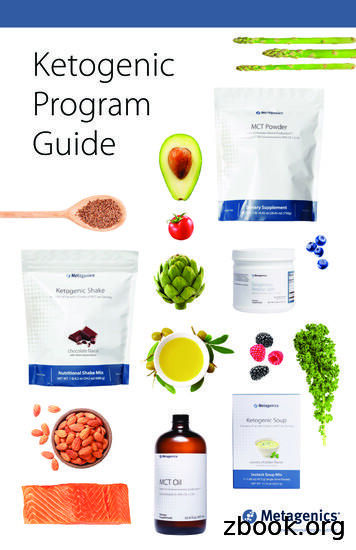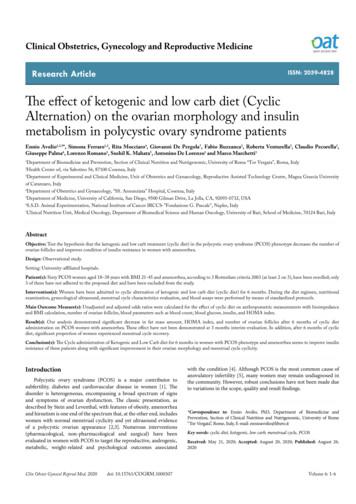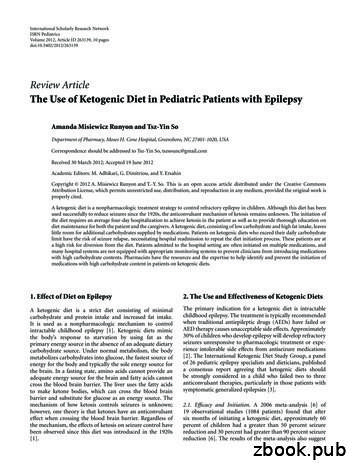Daily Cyclical Ketogenic Diet – With Meal Plan
genic-diet-meal-plan/Daily Cyclical Ketogenic Diet – with Meal PlanAuthors: Matt Fitzgerald, MS, MBA & Dr. John Fitzgerald, DCOverviewThe #1 issue with the Standard Ketogenic Diet (SKD) is a complete lack of focus on micronutrients.Fruits, Vegetables, and Superfoods are the best source of micronutrients, but they are high incarbohydrates; and carbohydrates are only allowed in very small amounts by the SKD.The meal plan we have devised follows the ketogenic diet and incorporates Superfoods toeliminate the typical problems people experience with The Standard Ketogenic Diet - such asconstipation, bad breath, muscle cramps, low electrolytes, low vitamins and low intake of thefoods with the most health benefits.Instead of following the Standard Ketogenic Diet, we propose a different type of Ketogenic Dietcalled the Daily Cyclical Ketogenic Diet (DCKD). In this diet, you are in ketosis for 20 hours perday and out of ketosis for 4 hours per day. During the 4 hours per day that you are out ofketosis, you are eating high micronutrient foods (like superfoods, vegetables, and fruits).If you are a little new to the Ketogenic Diet or want to really understand the details behind thewhat/how/why to what this diet is, please first read this article: Ketogenic Diet Overview - ABeginners Guide.1 Page
genic-diet-meal-plan/Cyclical Ketogenic Diet Meal CategoriesThe meal plan will consist of consuming foods in 4 different categories: Ketone Booster, VeryLow Carb (VLCARB), High Micronutrient, and Intermittent Fast.Ketone Booster Meal Category:This meal category is meant toboost your ketone levels andprovide you with energy.Ketone Boosters are high inMedium Chain Fatty Acids(MCT's), which your body is moreeasily able to convert intoKetones than other types of fat orstored fat. High levels of MCT'sare found in Coconut Oil (65% ofthe fat in Coconut Oil is MCT's).The most common Ketoneboosters are: Keto Coffee (aka"Bulletproof" coffee)Matcha Keto LatteRecipes for Keto Coffee and Matcha Keto Latte differ, but typically it's just: 1 Cup Coffee or Matcha Tea1 Tbsp Coconut Oil or MCT Oil1 Tbsp Grass Fed Butter or Grass Fed GheeOptional: Heavy CreamWe propose adding superfoods to this recipe to make them "Superfood Keto Coffee" and"Superfood Matcha Tea Latte".Superfoods like Cacao, Cinnamon, and Maca are the most common superfoods added to KetoCoffee.There are 2 primary reasons we recommend adding superfoods:1.Superfoods are dense in micronutrients. One of the biggest issues with the StandardKetogenic Diet is a lack of micronutrients. Adding superfoods to your Ketone Booster willhelp overcome this gap.2. Superfoods are high in antioxidants, which remove free radicals from your body. Thereason this is so important for the Keto Diet has to do with LDL ("Bad") Cholesterol. KetoCoffee and Keto Matcha Latte are very high in saturated fats - which can raise cholesterollevels. When LDL Cholesterol interacts with a free radical, the free radical will oxidize the2 Page
genic-diet-meal-plan/LDL Cholesterol and turn it into Oxidized LDL ("Very Bad") Cholesterol. This is badbecause Oxidized LDL Cholesterol is what can clog your arteries. By adding highantioxidant superfoods to these drinks, you are helping reduce your free radicals, thuslowering the ability of LDL Cholesterol from turning into Oxidized LDL Cholesterol.Keto Coffee and K eto Matcha Latte are very high in saturated fats which can raise LDL ("Bad") chol est erol l evels.Free Radical s can turn LDL Cholest erol into Oxidi zed LDL ("Very Bad")Cholesterol.This is very bad because Oxi dized LDL C holest erol i s what can clogyour arteries.Anxioxidants help remove free radi cals from your body, th us l oweringthe ability for LDL C holest erol t o turn in to Oxidized LDL Cholesterol.This is why we recommended adding high antioxidant superfoods tothese drinks; and to the Ketogenic Diet i n general.Very Low Carb Meal Category:This meal category is meant to keep you in ketosis. You want to follow the standard SKDmacronutrient breakout for this meal (70-80% fat calories, 15-20% protein calories, and 10% carbcalories) for this meal.Remember: for the keto diet, we are looking for very low carb, high fat, and low protein. This isbecause fats are converted into Ketones while protein is not.Here are a list of foods we recommend: Best Seafood with Low Mercury: anchovy, butterfish, catfish, clam, crab, crawfish, croaker(Atlantic), flounder, haddock (Atlantic), hake, herring, jacksmelt, mackeral (north Atlantic),mullet, oyster, plaice, pollock, salmon (canned or wild), sardine, scallop, shrimp, sole(Pacific), calamari, trout (freshwater), whitefish, whiting.Best Dairy with Low Protein (try to find grass fed dairy): Butter, ghee, heavy whippingcream, cream cheese, sour cream, brie, cheddar and parmesan cheeseBest Nuts and Seeds: Almonds, black cumin seeds, black sesame seeds, brazil nuts, chiaseeds, flax seeds, macadamia nuts, pecans, pumpkin seeds, sunflower seedsBest Fruits: Avocados, OlivesBest Vegetables: Asparagus, broccoli, Brussel sprouts, cabbage, cauliflower, celery,cucumbers, eggplant, any greens, kale, garlic, mushrooms, onion, parsnips, peppers,rutabaga, tomatoes, zucchini3 Page
genic-diet-meal-plan/ Best Meats: Bacon (nitrate free), Grass fed beef, lamb, wild game meatsBest Fats and Oils: Coconut oil, cocoa butter, grass fed butter or ghee, lard or tallow fromorganically raised animals, duck fat, extra virgin olive oil (don’t heat)Best Sweeteners: SteviaHigh Micronutrient Meal Category:This meal category is meant to pack in dense micronutrient foods. We want these loaded withantioxidants. Just remember that the more carbs you consume during this meal - the longer youwill stay out of ketosis. So you still want to watch your carbs, because our goal is to have you inketosis for as long as possible.The best foods to be eating during this meal is nutrient dense fruits, vegetables, and superfoods.We recommend a superfood smoothie and a very easy way to do this.If you want to calculate how long you will be out of ketosis for, you can consider each caloriecoming from net carbs 1.4 minutes out of ketosis.As an example, let’s say you eat 128 calories from net carbs. You would take 128 1.4 91minutes. So you would be out of ketosis for roughly 1.5 hours if you consumed 128 calories of netcarbs.Want to see more detail for how/why? Read below (bullet points correlate with the picture thatfollows) . "Net carbs" (Step 1) is a term that represents the total amount of carbs without the fiberincluded (since fiber cannot be converted into glucose, we don't need to worry aboutfiber). Or if you like math: Total Carbs - Fiber Net Carbs."Calories from Net Carbs" (Step 2) can be calculated by taking Net Carb Grams x 4 Calories from Net Carbs."Minutes out of Ketosis" (Step 5) can be calculated by taking the Calories from Net Carbs 1.4 Minutes out of Ketosis.That "1.4" number from above can differ per person and represents how many minutes ittakes your body to burn off 1 gram of net carb. The real number is dependent on a.) yourmetabolism rate and b.) how your body reacts to burning carbs vs. fat vs. protein. If youwant, you can adjust this number based on your metabolim rate (Steps 3 and 4).Here's an example:4 Page
genic-diet-meal-plan/Intermittent Fast Meal Category:It may seem a little odd to have this as a "meal category", but this really just means "skip a meal"or consume 0 calories.Many people following the Keto Diet to lose weight will also incorporate intermittent fasting (ormeal skipping) into their plan. We like to promote consuming all your calories within a 6 hourwindow. So let’s say you consume all your calories between noon - 6pm each day. You are thenin a fasted state for 18 hours per day.In a fasted state, you will be burning stored fat for energy - thus a fasted state is also a state ofketosis. In fact, fasting is the original Ketogenic Diet. The Ketogenic Diet was created to try tomimic the mental state of the body that occurs when you're fasting (e.g. having your brainingrunning off ketones instead of glucose).5 Page
genic-diet-meal-plan/Cyclical Ketogenic Diet Meal PlanFirst 10 Days: Adaptation PeriodThe first 10 days of this plan is to get your body "Fat Adapted".Your body is so used to being fueled by carbs/glucose, that it isn't efficient at using fat as energy.Try skipping a meal sometime. If you are not fat adapted, your body will make meal skippingvery painful because it's too used to getting glucose for energy and not efficient at using storedfat for energy.For the first 10 days, we want you to to follow the Standard Ketogenic Diet. This means that all ofyour meals should be coming from the Very Low Carb and Ketone Booster food categories.Your total net carb intake for the day should be less than 10% of your total calories.To make this process easiest, we do not recommend fasting or being calorie deficient during theadaptation period. Allow your body this time to adjust to using the fat from food for energy.After the fat adaptation period, then you can lower your calorie count or implement intermittentfasting - which will have your body using your stored body fat for energy.The reason why most people say, "I could never skip a meal or I would feel terrible" is becausethey are not fat adapted and their bodies are not efficient at pulling energy from stored fat. Wewant to get your body to a place where the metabolic pathways can easily switch betweengetting its energy from glucose (from food), fat (from food), and fat (from your stored body fat).6 Page
genic-diet-meal-plan/Ongoing Plan (After theAdaptation Period): DailyCyclical Ketogenic DietMeal PlanThe general rule of theDaily Cyclical KetogenicDiet is to have one HighMicronutrient Meal per dayand the rest of your mealsor snacks should comefrom the other mealcategories (KetoneBooster, Very Low Cart, orIntermittent Fast).When you choose to havethese meals- it is up to whatever works best for you. Most people will choose to have aSuperfood Keto Coffee (a Ketone Booster) in the morning in place of their breakfast; and then doa high micronutrient meal as their lunch, followed by a very low carb meal for dinner.Try not to consume more than about 200 calories (50 grams) of Net Carbs from your HighMicronutrient Meal. Consuming too many carbs from this meal will prolong how long you areout of ketosis for. Here is a link to some low net carb superfood smoothie recipes that youshould consider for the High Micronutrient Meal.Below is an image of some example daily cyclical ketogenic meal plans that we like. The bestplan(s) are the ones that you are likely to follow long-term. It will be different for everyone,which is why these are just examples. You may like doing Example 2 every day of the week, andthere is nothing wrong with that.If your goal is weight loss, you can lose weight using any of these examples, just as long as yourtotal calorie consumption is less than your metabolism rate. However, if you want to reallyaccelerate weight loss, see if you can do a fasting day (example 4) 1-2x per week and 6-hourwindow day (example 5) 4-5x per week.7 Page
genic-diet-meal-plan/8 Page
Instead of following the Standard Ketogenic Diet, we propose a different type of Ketogenic Diet called the Daily Cyclical Ketogenic Diet (DCKD). In this diet, you are in ketosis for 20 hours per day and out of ketosis for 4 hours
Ketogenic Diet Ratio Fat Ketogenic Carbohydrate & Protein Anti-Ketogenic Ketogenic diet ratios typically range from 3:1 4:1. Modified Atkins diet is usually a 1:1 ratio and Low Glycemic Index diet (LGIT) is 1:1. Ex: If the patient is on a 3:1 diet 3 grams of fat : ½ gram pro and ½ gram CHO
Most people will tell you a low-carb, high-fat ketogenic diet is a journey in its own right, filled with triumphs and challenges. Climbing the ketogenic diet hierarchy of needs is simple, but not always easy. If you are brand new to the ketogenic diet, you may
2 What are the benefits of a ketogenic diet? The benefits of following a ketogenic diet may include weight loss, an increase in cognitive performance, balanced blood sugar, and improved cardiovascular health.3-8 Mental focus—With a ketogenic diet,
KETOGENIC DIET The ketogenic diet is a very low-carb, high-fat diet. Standard ketogenic diet (SKD): This is a very low-carb, moderate-protein and high-fat diet. It typically contains 75% fat, 20% protein and only 5% carbs. Foods to eat: Meat: Red meat, steak, ham, sausage, bacon, chicken and turkey. Fatty fish:
proposed diet and have been excluded from the study. Dietary treatment We selected 2 different diet, ketogenic (KD) and very low carb (VLCD), in which the daily kcal amount was calculated subtracting to the estimated basal metabolism 1000 kcal/day. We considered a diet as ketogenic, when a number of carbohydrates were 20 g/day.
step of the ketogenic diet process must be managed by an experienced treatment team, usually based at a specialized medical center. Getting started Th e diet usually starts in the hospital with a 24 hour fast, although sometimes the ketogenic diet team opts to start it as an outpatient. Th e child is closely watched to be sure he or she is han-
ketogenic diet, the modified Atkins diet, the low-glycemic index treatment diet, the medium-chain triglyceride (MCT) diet, and the modified MCT diet (Table 1 )[4]. The classic ketogenic diet is the oldest of the diets and is one of the strictest of the diets. A gram scale is required to weigh food portions because no estimations are permitted .
conforming to ASTM F480 and (ASTM D1785 or ASTM D2241): (check one): Schedule 40 Schedule 80 Schedule 120. Thermoset Plastic: (check one) Filament Wound Resin Pipe conforming to ASTM D2996 Centrifugally Cast Resin Pipe conforming to ASTM D2997 Reinforced Plastic Mortar Pressure Pipe conforming to ASTM D3517 Glass Fiber Reinforced Resin Pressure Pipe conforming to AWWA C950 PTFE Fluorocarbon .























